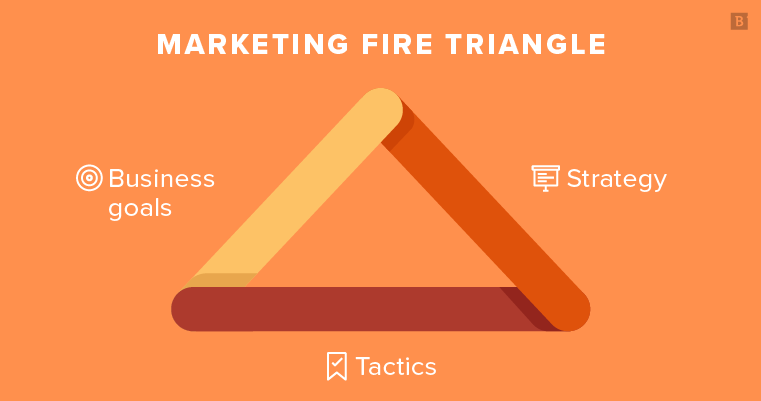Remember the fire triangle from way back in grade school science class?
You know the one — it shows a flame’s anatomy:

The fire triangle’s marketing equivalent would look something like this:
- Business goals.
- Strategy.
- Tactics.
Most marketers have goals, but many lack a unified strategy for achieving them. Instead, they skip straight to tactics, which often leads to outcomes like:
- An e-commerce site increasing its paid search budget without any boost in sales.
- A SaaS vendor writing hundreds of blog posts in a year only to see a marginal increase in web traffic and no commercial gains.
- A lifestyle brand’s newsletter that doesn’t drive any traffic to the site and has a high unsubscribe rate.
Simply put, tactical marketing and strategic marketing aren’t the same — and, accidentally blurring the line between them could smother any hopes of achieving your goals.
So, we’ve put together this article to help explain the difference so that you can burn bright with the best ROI possible. We’ve also included four stellar examples to help make the theory more concrete (knock on wood).
A Quick (but Crucial) Aside About Goals …
Simply put, marketing goals inform what kind of strategy you design and which tactics you’ll need to achieve each objective. They should counteract your weak points and capitalize on your strengths. Increasing site traffic is a marketing goal, not a business one. Getting more engagement on social media is also a marketing aim — again, nothing to do with business.
This is an important distinction for the simple reason that all marketing should have commercial value.
A marketing strategy will help you make sure that any marketing goal you set is, in fact, worthwhile for the organization. In other words, a good strategy makes sure that business goals and marketing goals are always aligned with one another.
But, it’s not good enough to have a heap of mingled goals. You need to categorize them based on whether they’re long-term or short-term. Long-term goals drive sustainable growth, but you need short-term ones to deliver immediate results in the interim.
For example, pay-per-click marketing will give you more conversions (a type of goal) in a few months, but you need search engine optimization (SEO) marketing that will create traffic (another kind of goal) in the long run when your budget has dried up.
You must also create a timeline for goals. Decide which ones need to be reached before you can begin working on others. Not all goals need to be worked toward in a linear fashion, but some require it. For instance, you can’t increase social media engagement before you have enough followers (that’s your brand awareness right there).
Having a series of small goals that culminate in a larger overall goal is an integral part of creating a strategy and choosing your tactics.
Subscribe to
The Content Marketer
Get weekly insights, advice and opinions about all things digital marketing.
Thank you for subscribing to The Content Marketer!
Now on the Matter of Marketing Strategy vs Tactics …
A marketing strategy is a high-level game plan for reaching a target audience and engaging them to achieve your business goal. That goal might be to control a larger market share, grow your business, expand into new industries, etc.
As part of the strategy, you need to understand your audience and create a competitive advantage to win them over. That’s where the 4 P’s of marketing (product, place, price, promotion) come in. Use them to differentiate yourself from your competitors and make your offering appealing.
TLDR: Your marketing strategy is your outline for achieving your goals. But, you’ll need tools to do that.
Enter marketing tactics: the activities you use to execute your strategy. These include:
- Email.
- Social media.
- PPC like Google Ads.
- SEO.
- Blog marketing.
- Radio and TV.
- Influencer marketing.
- Business videos.
- And so on, and so forth.
It’s crucial to remember that not every marketing tactic is well-suited to a certain goal/strategy. Let’s make that a bit more tangible with an example: Local partnerships are great for increasing brand awareness because they get the word out, but they might not necessarily result in higher conversions.
A bit of research will help you determine which tactics are best for your marketing objectives. Doing your due diligence is vital to avoid wasting resources. There’s no point pouring time, effort and money into a tactic if it doesn’t give you any return on what you’re investing in your marketing campaign. Strategic planning prevents poor performance and protects your investment.
The tactics you choose will also be dependent, to a degree, on your business’ size. Small businesses benefit far more from local SEO for brand awareness and community outreach for brand engagement than a bigger one that can capitalize more on radio and TV.
But, back to how tactics work with strategy: You can have dozens or even hundreds of marketing tactics that make up your marketing mix, but only one marketing strategy.
A good strategy encompasses:
- Marketing goals: What do you need your marketing to accomplish to achieve a greater business goal?
- Target audience: Who do you need to connect with to reach your marketing goals?
- Brand guidelines: How should you engage your target audience (e.g., what type of brand are you, and how will that reflect in your advertising, digital marketing strategy and/or content marketing strategy)?
- Opportunities and threats: What are the rewards and potential risks that you need to keep in mind, and what competitive advantage do you bring to the table?
Where Does ‘Marketing Plan’ Fit Into the Equation?
If the strategy is the why of marketing and the tactics are the what, the marketing plan is the how. It’s the phase between strategy and tactics where you decide and document which tactics you’ll use to execute your strategy.
So, going back to our fire analogy:
If your strategy is the fuel for your fire and your tactics are your heat source, your plan is where you decide which fire-starting tactic makes the most sense for your situation (bow drill, flint and steel, lighter, Charmander?).
Your marketing plan is also where you decide what key performance indicators (KPIs) you’ll use to track success.
When you’re trying to start a fire, smoke might be a good KPI telling you that your tactics are working. In marketing, the KPIs you need to monitor will vary depending on your strategy and your strategic plan.
Bear in mind that your strategic marketing plan isn’t the same as a content plan, which is specific to content marketing (but, that’s a topic for another day).

What Are Some Examples of Strategies and Their Tactics?

Goal 1: Reinvent or rebrand your business to appeal more to a modern audience.
- Strategy: Give your brand a complete digital facelift and implement new web-facing services.
- Plan: Decide what tactics you’ll use to achieve this goal, what your timeline will be, how much budget you’ll allocate, who’s responsible for what and how you’ll monitor progress.
- Tactics: Produce an original website with fresh content and entirely novel UX and design, launch a mobile app and promote your new and improved branding efforts on social media, email and other distribution channels.
Goal 2: Increase revenue cost-effectively with the long-term goal of growing your business.
- Strategy: Use digital marketing to lower your cost per lead and, more specifically, revamp your inbound marketing activities.
- Plan: Choose what content marketing and digital advertising tactics you’ll use to improve inbound business, what mediums you’ll invest the most time and effort into and how you’ll measure development.
- Tactics: Use SEO such as targeting relevant keywords in your website copy and blog posts to improve inbound traffic, leverage on-page calls to action to capture leads and implement email marketing tactics (like newsletters, lead nurturing emails and email drip campaigns) to nurture them.
Goal 3: Launch a new line of products or services.
- Strategy: Do market research on the competition, identify your audience and potential customers for this new product, figure out how you want to present your new offerings to them and on what platforms and map out the customer journey.
- Plan: Describe your parameters for competitive analyses (what details you’ll focus on), pinpoint your target market, decide how to best reach them and determine what your go-to-market messaging should be.
- Tactics: Create audience profiles, develop buyer personas, define your marketing mix around their preferences; employ your key advertising (display ads, paid search, commercials) and marketing tactics (content marketing, event marketing, social media marketing, etc.).
Goal 4: Cement brand loyalty among current consumers
- Strategy: Create a marketing campaign to increase brand awareness of historically best-selling products or services to elevate market share.
- Plan: Conduct research into competitors’ similar offerings, ascertain current market penetration rate as a metric, select the most appropriate marketing channels based on buyer personas and create appropriate marketing collateral.
- Tactics: Design visuals and videos, write advert copy and produce PPC/social media/email assets to use in corresponding campaigns.
Don’t Be Afraid To Correct Course
If you want to do marketing that has actual commercial value, you first need to understand the difference between a marketing strategy and marketing tactics.
Remember: Build your marketing strategy around goals, and then introduce tactics that will actualize your strategy.
If, at any point, you find that certain efforts aren’t kicking up sparks, weed out the tactics that are underperforming.
Keep at it. Marketing is a slow burn.
But, do it right, and that fire will stay lit for years on end.
Editor’s Note: Updated on October 2023.





